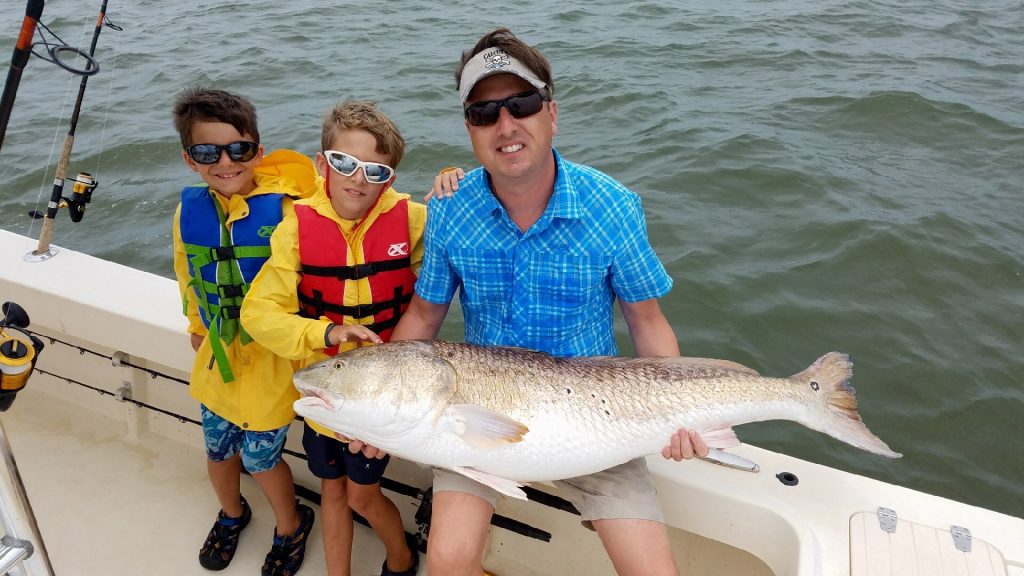Hatteras – July 6, 2017
Mike, of Hatteras Jack, reports that those fishing the surf zone are filling the coolers with sea mullet and the occasional pompano while using fresh shrimp and sand fleas on double drop rigs. In addition, those casting Stingsilvers and Hopkins spoons from the surf have landed plenty of spanish and bluefish in the 1-4 lb. range. A small number of cobia have also been seen close to the beach and hanging around bait pods.
Anglers fishing inshore have been landing good numbers of red drum and speckled trout while fishing Gulp plastics on the bottom and under popping corks. Live shrimp has also been working well for the trout, and the redfish will take a piece of cut mullet on a Carolina rig.
Flounder have started moving inside in better numbers, and using live mud minnows or finger mullet around dock structure has produced best. Most of the flatfish have been between 15-19”.
Fishing around area bridge structure with sand fleas has boated good catches of sheepshead. Using a sharp j hook is the key to connecting with high numbers of the sheepshead.
Clyde, of Rodanthe Pier, reports that tossing fresh shrimp from the pier has landed plenty of croaker. Bluefish and spanish have been willing to hit a Gotcha plug jigged from the pier in the morning hours. A few striper have also been landed. The water temperature is 77 degrees.

Phoebe Kot, of Wilmington, NC, with a 60 lb.yellowfin tuna. The fish was fooled by a ballyhoo behind a green lantern skirt. Kot was trolling in 75 fathoms with Capt Rob Orr out of Ocracoke, NC.
Lucas, of Frank and Fran’s, reports that surf anglers are having luck landing puppy drum while using cut bait. Those fishing with fresh shrimp have caught sea mullet, croaker, and pompano.
When throwing Gotcha plugs from the pier, spanish and bluefish have been landed in good numbers.
Tobi, of Avon Pier, reports that spadefish and flounder having been willing to take fresh shrimp on the bottom. When tossing Gotcha plugs, bluefish and spanish have also been hooked.
A few mahi were landed from the end of the pier.
Cameron, of Frisco Tackle, reports that anglers fishing the surf have landed sea mullet and pompano, and the ticket for producing bites has been fresh shrimp, sand fleas, and bloodworms. Red drum have also been in the surf zone, and cut mullet fished on the bottom has done the job best.
Casting Gotcha plugs from the beach has produced some high numbers of bluefish and spanish. Tarpon have also been spotted moving up the beaches.
In the sound, anglers are catching limits of red drum on live mud minnows pinned on Carolina rigs. When working pearl white Gulp shrimp on the bottom, speckled and gray trout are being landed.
Flounder have moved inside in good numbers, and most fish are falling for live minnows fished on Carolina rigs. The majority of the flounder have been between 17-25”.
JAM, of Teach’s Lair, reports that the yellowfin tuna bite has been hot offshore, and many fish brought in have been between 50-75 lbs. Landing 5-6 fish per trip has not been uncommon. Also in the 18-22 mile range, a few anglers have been lucky enough to land and release a couple billfish.
Inshore fishing for cobia is still steady around the inlets and in the deeper holes. Drifting dead baits and jigging bucktails has worked best for the cobia.
Big bluefish have been feeding around the inlets, and some smaller spanish have been in the mix as well.
Red drum fishing has been consistent, but the size of the fish has varied greatly. Some anglers are landing lower-slot fish, and others are hooking in to over-slots while fishing live minnows or cut bait on Carolina rigs.
Aaron, of Tightline Charters, reports that sight-casting with gold spoons has been the key to catching slot reds on the grass flats. Schools of bluefish around the 2 lb. mark have also been willing to take a spoon on the flats.
Around Hatteras Inlet, big schools of redfish have been holding in the area. Sight casting to these fish with bucktails has been the best method.
Cobia are still scattered throughout the nearshore area as well as near the inlets. Fishing with live bait is the best way to land these few remaining cobia.
Jay, of Bite Me Sportfishing, reports that dolphin fishing has remained consistent when trolling ballyhoo. Many double digit days have been had by anglers venturing offshore, and most dolphin landed have been gaffer sized.
Sailfish have also been mixed in when trolling ballyhoo offshore.

Bill Hayes, of Gastonia, NC, and son Luke (center) and nephew Graham (left) caught and released this 52″ red drum. They were fishing with Capt. Justin Revere on the charter boat Adventure.
Bill, of Predator Sport Fishing, reports that in the 20-25 mile range, trolling and using spinning gear to pitch out baits has worked well on landing limits of bailer dolphin. Pulling skirted ballyhoo has also produced blackfin tuna.
Jigging the nearshore wrecks and reefs offers good numbers of amberjacks. A little further out, tilefish have been landed fishing the bottom with cut bait.
Yellowfin tuna are still feeding well in the area, but you just have to cover a good amount of water to find the bigger concentrations of fish. Running north out of Hatteras Inlet has been the key.
Jimmy, of Tradewinds Bait and Tackle, reports that fishing from the surf has been up and down, but most anglers putting fresh shrimp and sand fleas on the bottom are still landing a few small flounder and sea mullet. When tossing bigger cut baits, anglers are having luck with a few puppy drum and bluefish.
Spanish are also mixed in the surf, and anglers tossing Stingsilvers and Hopkins spoons are having the best luck with the spanish.
